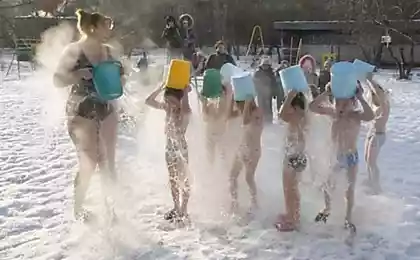723
We live in the coldest country in the world. But do you know how cold it?
Russian residents at school know that their country - the largest in the world. But she is also - very cold! And it is not just words. If you think - we live in a harsh environment, little suited to a person's life, and we do not consider this fact something vydayuschimsya.Redaktsii Website in the eyes got the text that surprised us the order. It turns out that even Canada and the Scandinavian countries, which are traditionally compared the harsh Russian climate - very warm and comfortable country compared with Russia. Judge for yourself ...

«Who does not know that we live in the coldest country in the world? Everybody knows it. But there are, as far as she is cold? How many people, even educated people believe that in the capital of England, London, palm trees and bamboo.
We built their own state, where no one else lives If you are reading English detective, likely We noticed that the description of a classic English manor necessarily mentioned yew alley. In the US, the group's most prestigious universities - Harvard, Yale, Stanford, Princeton, etc. -.. Called the "Ivy League" of their old buildings, ivy. We have these evergreen plants - ivy and yew - only grow in the Crimea and the Caucasus
. If the US is not surprising - many have heard that this country is geographically located to the south of Russia, something about the "terrible English climate," we usually think differently. Once I met friends at Sheremetyevo in mid-February, brought to them upon their request, warm clothes. In Moscow, it was minus 20 degrees, and in England as well, but plus
The average annual temperature in Russia -. 5 minus 5 degrees Celsius. In Finland, for example -. Plus 1, 5 degrees I remember, in "Hunting and Hunting" magazine was once a discussion -. Why in Finland relatively large moose (per unit of forest area), and we have little < br>
First, they cut down, as usual, on socialism, yet did not find a knowledgeable person to explain that in the taiga zone - the north-east Finland - density of elk as we do, but the western part - the zone of deciduous forests. There are mainly moose (and Finnish) and live biological productivity of forests and fields almost an order of magnitude higher in the area.
And the average annual temperature - not all. There is such a thing as the severity of the climate - that is, the difference between summer and winter temperatures, and the difference of night and day. Here we are out of the competition. It freezes a man in the winter, even if the summer is hot and we have.
< We have built their own state, where no one else lives.
Interestingly, there are several paradoxical European climatic zones. The climate gets colder not from south to north and from east to west, and sometimes vice versa - from north to south, or rather, from the coasts inland. Note: in Leningrad warmer than in Moscow, and he is 400 kilometers to the north. In Helsinki winter is warmer than in Orel, although Helsinki 1000 km to the north. < Under Vilnius in June, kept pace with cherries, and in the Moscow region - not because winter freezes. And the breadth of the same! Vilnius 1000 km to the west, here and its cherries on the market.
In Latvia the poor refuse to heating and hot water (because of cost). It's cold, of course, but as long survive. Try at least even in Kursk for the winter heating disable! But Latvia significantly north. Western Europe, according to our notions - subtropics. The reason is known even from school - the Gulf Stream. Thanks to him, the winter in Europe, is above zero, and the spring begins in January and February, and almost always in the same time. We have the same spring can occur at the end of March and a month later. Why? If not from the west of warm air intrusion, the heating is only due to radiation from the sun.
It appears, in this case the snow melts in Moscow at the end of April, and if the wind is from the west - in the beginning. In Western Europe, the warm wind blows always, therefore, to the same (note gardeners), there is no frost.
"In winter isotherm in Europe, except for the North, are in the meridional and latitudinal not" write geographers. What does it mean? This means that on the severity of the winter climate alike: habitable part of Norway, south of Sweden, Denmark, the Netherlands, Belgium, West Germany (except Bavaria), Eastern and Central France, northern Italy, Croatia, Albania, North Greece, the coastal regions of Turkey, southern coast of Crimea and the Caucasus coast. The average January temperature is higher than zero. But Norway for more than 3000 km to the north of Greece!
England, Western France, Spain, Portugal, southern Italy and Greece - still warmer and more about each other as equal. In January there plus 5-10 degrees.
< Western Europe is a unique region. nowhere in the world there is no place situated so close to the pole, and so warm. All US comparable climate to Western Europe, geographically located to the south of the Kuban. New York - about Sochi latitude. So lovely to our hearts open spaces unsuitable for life. Yes, on the territory, we are still the largest country in the world. But there is such a thing as "effective area", ie the area suitable for life.
French geographer of the last century, Jean Elisee Reclus in his work "The Earth and people. Universal geography "called « effective » area, which is not higher than 2000 meters above sea level, with an average annual temperature not below minus 2 degrees Celsius. It is believed, and the entire human experience confirms that the only on the effective area can be relatively normal human activity.
So, on the effective area we are in fifth place in the world, rather than on the ground. Only one-third of our land - "effective". But our effective area - the coldest in the world. We are not India, not China or even Canada. Imagine an environment where people with no special protective devices inevitably die after a few tens of minutes. This is not the mouth of the volcano, this is our country in the winter. Simply, these guards are called "warm clothing" and "heated rooms." Once on the street person, so to speak, in its natural form, it does not have a better chance of surviving than had fallen overboard in the middle of the ocean. We just do not notice the situation in which we live. Deer grazing in our country (19% of the area) is significantly greater than the usable agricultural land (13%), and of our arable land (about 100 million hectares) is hardly enough for the self-Russian bread.
How many times have you heard that Canada and Scandinavia as cold country like Russia? It's not like that at all. Canada is similar to Russia, but nevertheless it is - not Russia. Although on the map it looks pretty compact country, real people live there in two disparate regions: the east - from the Atlantic and the Great Lakes and the west - on the Pacific coast. Compared to the whole territory of Canada - a tiny noses pressed to the southern border. In the 1930s, even the communication between the two regions was only on the territory of the United States
The habitable part of Canada -. Much more favorable country than Central Russia The average annual temperature in Moscow +3. 8 degrees, in Leningrad, 4, 3 degrees. In Vancouver, for example, 9, 8 degrees. (As in Vienna, Odessa, Sofia), in Montreal 6, 7 degrees. (In Warsaw).
Generally one degree of mean annual temperature - it's actually very sensitive. Habitable Canada - it is quite Western Europe, not Moscow region, and although there poprohladney summer, winter in Montreal, softer even than in Poland. Indeed, the city is there even in colder (average) climate, than Moscow, for example, Edmonton - 2, 7 degrees, Winnipeg 2, 5 degrees, which is about how we in Ivanovo... But look at the map of the industry, at least from the school atlas - a purely commodity areas: petrochemicals, wood processing. And at the latitude of Moscow in Canada are located only settlements with "speaking" names like Uranium City or Port Radium.
Even in the relatively (by Canadian standards) cold regions more favorable weather conditions than in Central Russia for agriculture. For plants, it is important not only to the annual average temperature, but also indicators such as the sum of positive temperatures, or, as some say, the sum of temperatures above 10 degrees. C. These figures are for s / s parts of Canada are much better than in Russia. This is especially true of such crops are sown in spring and which do not have to spend the winter under the snow, that is spring.
To summarize. Canada - a large country with a small population and excellent transport facilities, ie access to the ocean... Climate habitable, industrialized part of Canada roughly corresponds to the climate of the Rostov Region and Krasnodar Territory, but it is more humid. This part of the habitable enough about 24 million for the Canadian population. The rest of the territory - only the extraction of raw materials and tourism
. And Scandinavia - not as Siberia, as people think. "... As you know, the Scandinavian peninsula and Finland constitute a special Atlantic-Arctic climate region. Winters are characterized by frequent cyclones coming from the Atlantic. ... Even the winters accompanied by the strong influence of the Atlantic, which causes a sharp warming. ... It is important to note that there are no spring "returns cold", ie frost and therefore agricultural work starts fairly early. In the summer in Northern Europe formed a low-pressure area on a regular basis, so the drought is not the case, and a large number of spring-summer cloudy days (especially in Finland) does not inhibit plant growth, as offset by lengthening daylight hours. This is typical for the whole of Northern Europe. »
In addition to the average temperature of great importance for the economic life has already been referred to the severity of the climate, that is, except for the cold, and even the temperature difference. If in the coastal areas of Europe, this figure - the difference absolute ever marked maxima and a minimum temperature of - 40 degrees in the rest of Western Europe (with the Oder and the Danube) - up to 50 degrees, in Finland, the Baltic States, Poland, Slovakia and European countries of the CIS - up to 60 degrees, while in Russia to the Urals - more than 70 degrees, and in Siberia - from 80 to 90 degrees (cooler than in the Antarctic in winter it is cold, but the summer is not so hot). And in Verkhoyansk -. And more than 100 degrees
can be compared only Mongolia Of the two hundred countries around the world on the severity of the climate with us in Ulaanbaatar on average cooler than on the coastal research stations in Antarctica. .
In Western Europe, a brief cold snap to what some of minus 10 degrees. C (every 20 years) causes complete disruption of economic life. And in the center of Russia -10 degrees. C - is the average temperature in January, that is quite common. It is important for business planning? Important. But zoning map by the criterion of the relative severity of the climate, I found only in the pre-revolutionary atlas. So that's how our climate impact in monetary terms? Similarly, no one knows, because, it seems, no one is interested.
But the impact is very strong. There is empirical evidence to assess the cost of the arrangement of the workplace, depending on winter temperatures; and so, for negative temperatures for each degree that the cost increases by tens of percent. I met and the claim that the mean annual temperatures below minus 2 degrees. - Even doubled with each new degree
. The text uses quotes from a book by Andrei Parsheva "Why Russia is not America" 2000
via rubin65.livejournal.com/456567.html

«Who does not know that we live in the coldest country in the world? Everybody knows it. But there are, as far as she is cold? How many people, even educated people believe that in the capital of England, London, palm trees and bamboo.
We built their own state, where no one else lives If you are reading English detective, likely We noticed that the description of a classic English manor necessarily mentioned yew alley. In the US, the group's most prestigious universities - Harvard, Yale, Stanford, Princeton, etc. -.. Called the "Ivy League" of their old buildings, ivy. We have these evergreen plants - ivy and yew - only grow in the Crimea and the Caucasus
. If the US is not surprising - many have heard that this country is geographically located to the south of Russia, something about the "terrible English climate," we usually think differently. Once I met friends at Sheremetyevo in mid-February, brought to them upon their request, warm clothes. In Moscow, it was minus 20 degrees, and in England as well, but plus
The average annual temperature in Russia -. 5 minus 5 degrees Celsius. In Finland, for example -. Plus 1, 5 degrees I remember, in "Hunting and Hunting" magazine was once a discussion -. Why in Finland relatively large moose (per unit of forest area), and we have little < br>
First, they cut down, as usual, on socialism, yet did not find a knowledgeable person to explain that in the taiga zone - the north-east Finland - density of elk as we do, but the western part - the zone of deciduous forests. There are mainly moose (and Finnish) and live biological productivity of forests and fields almost an order of magnitude higher in the area.
And the average annual temperature - not all. There is such a thing as the severity of the climate - that is, the difference between summer and winter temperatures, and the difference of night and day. Here we are out of the competition. It freezes a man in the winter, even if the summer is hot and we have.
< We have built their own state, where no one else lives.
Interestingly, there are several paradoxical European climatic zones. The climate gets colder not from south to north and from east to west, and sometimes vice versa - from north to south, or rather, from the coasts inland. Note: in Leningrad warmer than in Moscow, and he is 400 kilometers to the north. In Helsinki winter is warmer than in Orel, although Helsinki 1000 km to the north. < Under Vilnius in June, kept pace with cherries, and in the Moscow region - not because winter freezes. And the breadth of the same! Vilnius 1000 km to the west, here and its cherries on the market.
In Latvia the poor refuse to heating and hot water (because of cost). It's cold, of course, but as long survive. Try at least even in Kursk for the winter heating disable! But Latvia significantly north. Western Europe, according to our notions - subtropics. The reason is known even from school - the Gulf Stream. Thanks to him, the winter in Europe, is above zero, and the spring begins in January and February, and almost always in the same time. We have the same spring can occur at the end of March and a month later. Why? If not from the west of warm air intrusion, the heating is only due to radiation from the sun.
It appears, in this case the snow melts in Moscow at the end of April, and if the wind is from the west - in the beginning. In Western Europe, the warm wind blows always, therefore, to the same (note gardeners), there is no frost.
"In winter isotherm in Europe, except for the North, are in the meridional and latitudinal not" write geographers. What does it mean? This means that on the severity of the winter climate alike: habitable part of Norway, south of Sweden, Denmark, the Netherlands, Belgium, West Germany (except Bavaria), Eastern and Central France, northern Italy, Croatia, Albania, North Greece, the coastal regions of Turkey, southern coast of Crimea and the Caucasus coast. The average January temperature is higher than zero. But Norway for more than 3000 km to the north of Greece!
England, Western France, Spain, Portugal, southern Italy and Greece - still warmer and more about each other as equal. In January there plus 5-10 degrees.
< Western Europe is a unique region. nowhere in the world there is no place situated so close to the pole, and so warm. All US comparable climate to Western Europe, geographically located to the south of the Kuban. New York - about Sochi latitude. So lovely to our hearts open spaces unsuitable for life. Yes, on the territory, we are still the largest country in the world. But there is such a thing as "effective area", ie the area suitable for life.
French geographer of the last century, Jean Elisee Reclus in his work "The Earth and people. Universal geography "called « effective » area, which is not higher than 2000 meters above sea level, with an average annual temperature not below minus 2 degrees Celsius. It is believed, and the entire human experience confirms that the only on the effective area can be relatively normal human activity.
So, on the effective area we are in fifth place in the world, rather than on the ground. Only one-third of our land - "effective". But our effective area - the coldest in the world. We are not India, not China or even Canada. Imagine an environment where people with no special protective devices inevitably die after a few tens of minutes. This is not the mouth of the volcano, this is our country in the winter. Simply, these guards are called "warm clothing" and "heated rooms." Once on the street person, so to speak, in its natural form, it does not have a better chance of surviving than had fallen overboard in the middle of the ocean. We just do not notice the situation in which we live. Deer grazing in our country (19% of the area) is significantly greater than the usable agricultural land (13%), and of our arable land (about 100 million hectares) is hardly enough for the self-Russian bread.
How many times have you heard that Canada and Scandinavia as cold country like Russia? It's not like that at all. Canada is similar to Russia, but nevertheless it is - not Russia. Although on the map it looks pretty compact country, real people live there in two disparate regions: the east - from the Atlantic and the Great Lakes and the west - on the Pacific coast. Compared to the whole territory of Canada - a tiny noses pressed to the southern border. In the 1930s, even the communication between the two regions was only on the territory of the United States
The habitable part of Canada -. Much more favorable country than Central Russia The average annual temperature in Moscow +3. 8 degrees, in Leningrad, 4, 3 degrees. In Vancouver, for example, 9, 8 degrees. (As in Vienna, Odessa, Sofia), in Montreal 6, 7 degrees. (In Warsaw).
Generally one degree of mean annual temperature - it's actually very sensitive. Habitable Canada - it is quite Western Europe, not Moscow region, and although there poprohladney summer, winter in Montreal, softer even than in Poland. Indeed, the city is there even in colder (average) climate, than Moscow, for example, Edmonton - 2, 7 degrees, Winnipeg 2, 5 degrees, which is about how we in Ivanovo... But look at the map of the industry, at least from the school atlas - a purely commodity areas: petrochemicals, wood processing. And at the latitude of Moscow in Canada are located only settlements with "speaking" names like Uranium City or Port Radium.
Even in the relatively (by Canadian standards) cold regions more favorable weather conditions than in Central Russia for agriculture. For plants, it is important not only to the annual average temperature, but also indicators such as the sum of positive temperatures, or, as some say, the sum of temperatures above 10 degrees. C. These figures are for s / s parts of Canada are much better than in Russia. This is especially true of such crops are sown in spring and which do not have to spend the winter under the snow, that is spring.
To summarize. Canada - a large country with a small population and excellent transport facilities, ie access to the ocean... Climate habitable, industrialized part of Canada roughly corresponds to the climate of the Rostov Region and Krasnodar Territory, but it is more humid. This part of the habitable enough about 24 million for the Canadian population. The rest of the territory - only the extraction of raw materials and tourism
. And Scandinavia - not as Siberia, as people think. "... As you know, the Scandinavian peninsula and Finland constitute a special Atlantic-Arctic climate region. Winters are characterized by frequent cyclones coming from the Atlantic. ... Even the winters accompanied by the strong influence of the Atlantic, which causes a sharp warming. ... It is important to note that there are no spring "returns cold", ie frost and therefore agricultural work starts fairly early. In the summer in Northern Europe formed a low-pressure area on a regular basis, so the drought is not the case, and a large number of spring-summer cloudy days (especially in Finland) does not inhibit plant growth, as offset by lengthening daylight hours. This is typical for the whole of Northern Europe. »
In addition to the average temperature of great importance for the economic life has already been referred to the severity of the climate, that is, except for the cold, and even the temperature difference. If in the coastal areas of Europe, this figure - the difference absolute ever marked maxima and a minimum temperature of - 40 degrees in the rest of Western Europe (with the Oder and the Danube) - up to 50 degrees, in Finland, the Baltic States, Poland, Slovakia and European countries of the CIS - up to 60 degrees, while in Russia to the Urals - more than 70 degrees, and in Siberia - from 80 to 90 degrees (cooler than in the Antarctic in winter it is cold, but the summer is not so hot). And in Verkhoyansk -. And more than 100 degrees
can be compared only Mongolia Of the two hundred countries around the world on the severity of the climate with us in Ulaanbaatar on average cooler than on the coastal research stations in Antarctica. .
In Western Europe, a brief cold snap to what some of minus 10 degrees. C (every 20 years) causes complete disruption of economic life. And in the center of Russia -10 degrees. C - is the average temperature in January, that is quite common. It is important for business planning? Important. But zoning map by the criterion of the relative severity of the climate, I found only in the pre-revolutionary atlas. So that's how our climate impact in monetary terms? Similarly, no one knows, because, it seems, no one is interested.
But the impact is very strong. There is empirical evidence to assess the cost of the arrangement of the workplace, depending on winter temperatures; and so, for negative temperatures for each degree that the cost increases by tens of percent. I met and the claim that the mean annual temperatures below minus 2 degrees. - Even doubled with each new degree
. The text uses quotes from a book by Andrei Parsheva "Why Russia is not America" 2000
via rubin65.livejournal.com/456567.html
A friend in trouble will not leave: wonderful comic that touched our hearts
Tilly Cat waiting in a shelter owners for over 20 years























